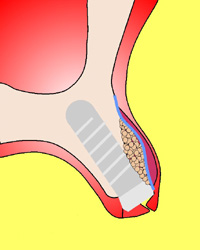|
Bone
grafting procedures
 Following loss of teeth, atrophy of the jaw alveolar process occurs, usually expressed as reduction of its height and width. Planning implantation operation usualy vertical and horizontal measurements are evaluated. The distribution of endosseous dental implants is restricted by insufficient alveolar ridge margins. Bone graft is a surgical procedure that replaces missing bone with material from the patient's own body (autogenous bone) or an artificial, synthetic, or natural substitute. The graft not only replaces missing bone, but also helps the body to regrow its own lost bone. This new bone growth strengthens the grafted area by forming a bridge between the existing bone and the graft material. Over time the newly formed bone will replace much of the grafted material.
Bone grafts are needed when part of the body is missing. This missing portion of bone is frequently called a "bony defect". Examples of jawbone defects are: defects which most often occur following loss of cortical bone in such conditions as tooth extraction; generalized decrease in quantity of jawbone from trauma or long-term tooth loss; defects surrounding "old style" dental implants; defects resulting from cysts or tumor surgery. These defects may also occur with bone loss caused by severe periodontal disease or endodontic abscess. Following loss of teeth, atrophy of the jaw alveolar process occurs, usually expressed as reduction of its height and width. Planning implantation operation usualy vertical and horizontal measurements are evaluated. The distribution of endosseous dental implants is restricted by insufficient alveolar ridge margins. Bone graft is a surgical procedure that replaces missing bone with material from the patient's own body (autogenous bone) or an artificial, synthetic, or natural substitute. The graft not only replaces missing bone, but also helps the body to regrow its own lost bone. This new bone growth strengthens the grafted area by forming a bridge between the existing bone and the graft material. Over time the newly formed bone will replace much of the grafted material.
Bone grafts are needed when part of the body is missing. This missing portion of bone is frequently called a "bony defect". Examples of jawbone defects are: defects which most often occur following loss of cortical bone in such conditions as tooth extraction; generalized decrease in quantity of jawbone from trauma or long-term tooth loss; defects surrounding "old style" dental implants; defects resulting from cysts or tumor surgery. These defects may also occur with bone loss caused by severe periodontal disease or endodontic abscess.
Guided Bone Regeneration (GBR)
Procedure refers to procedures that attempt to regenerate
bone prior to the placement of bridges or, more commonly, implants.
This is accomplished using bone grafts and biocompatible membranes
that keep out tissue and allow the bone to grow. GBR procedures involves
alveolar bone regeneration or onlay grafts, sinuslifting procedures
et cetera.



Sinus Augmentations:
One of the most frequently applied grafting procedures
is the Sinus Augmentation. This procedure is restricted only to the
upper jaw.
As we get older our sinuses grow larger in volume and
literally take away valuable bone from the jaw ridge. This is not
a pathological condition, on the very contrary, it happens to almost
every one. This process is called Pneumatization of the Para-nasal
sinuses.

 
Once teeth are lost in that particular area it makes
it difficult if not impossible to place endosseous implants in that
area. For this particular problem a grafting method was developed
to literally raise the bottom of the sinus back up, graft bone underneath
and, thus, create enough space for one or more dental implants.
Sinus Augmentations and implant placement can sometimes be performed
as a single procedure, if enough bone between the upper jaw ridge
and the bottom of the sinus is available to stabilize the implant
well. If not enough bone is available, the Sinus Augmentation will
have to be performed first, then the graft will have to mature for
several months (depending on the graft material used). Once the graft
has matured the implants can be placed.
 |






